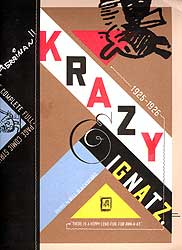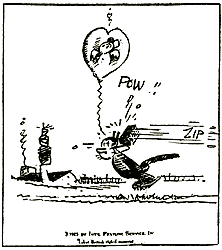
|
That is the sound of a brick kreasing a kat's kranium. Ignatz Mouse lives for making such a noise, just as Krazy Kat lives to hear it and Officer Pupp lives to prevent it. Krazy, you see, loves Ignatz. For him (or her, as Krazy's gender remains ambiguous) Ignatz' tossed brick arrives with as much love as any bouquet. Completing the ancient dramatic triangle, Officer Pupp's unacknowledged love for Krazy hides behind his bounded duty to prevent all such brick-tossing. Undoubtedly the most remarkable of all variations on a theme, Herriman managed to create decades-worth of strips around these compulsions without once violating the ambiguity of the relationships or harm their possibilities as metaphors. One remarkable strip in the new collection deconstructs the formula as vaudeville. Krazy crosses the stage. A brick flies across the stage. Ignatz crosses the stage. Ignatz in Officer Pupp's clutches crosses back over the stage. Close curtain.
But the poetry of "Krazy Kat" goes beyond its ambiguity of meaning. Herriman's images and language make for pure, direct pleasure. The characters live in a fantastical desert landscape made of potted Joshua trees, adobe jails and giant disembodied elephant's feet. As Krazy argues with Ignatz over whether summer comes before winter the background magically changes from panel to panel — Ignatz on a road; Ignatz atop a mesa; Ignatz in a birdbath, etc. Herriman's simple device to keep readers entertained both narratively and visually goes right the heart of a pure comic art. Cartooning has no obligations to reality except that of eternal human truths, and "Krazy Kat" exemplifies this high ideal.

|
Herriman played as well with verbal poetry as he did with visual. Puns, alliteration and copious phonetic wordplay fill the balloons and boxes. Krazy in particular has a remarkable patois like you've never seen before, combining Shakespearian sentence construction with strange malapropisms. To his worm pal he warns of the early bird: "He's a boid — and he's oily and he kraves a woim — ooy, l'il woim, l'il woim — I shudda and shiva for you." His bittersweet song of love goes, "There is a heppy lend — fur, fur awa-a-ay."
The new printing of this masterpiece couldn't be much better. Kudos to the publisher for keeping it an inexpensive softcover instead of going for the totally unnecessary hardcover "collectible" jugular. Herriman's best "Krazy Kat" work appeared in his full-page Sunday strips since this allowed him the most amount of freedom of form. So here they are, printed in chronological order with their date of publication. The collection's designer, Chris Ware (of "Jimmy Corrigan" fame), wisely makes his hand all but invisible. The strips are just black and white because William Randolph Hearst, syndicator and patron saint of the strip, ran it in the arts section of his papers rather than the color "funnies." Disappointingly Hearst also forced the strip into a strict layout beginning in the summer of '25, stifling Herriman's innovative page design.
The "Krazy and Ignatz" series, should it see its end, will make up a cultural loss as significant as finding a complete version of Eric Von Stroheim's "Greed." Like any great art work, during its own time "Krazy Kat," received as much mystified disdain as it got praise from many of the jazz-age "inelectjools." At least now we will be able to judge for ourselves whether Gilbert Seldes was correct when he wrote in 1924: "Krazy Kat, the daily comic strip of George Herriman is, to me, the most amusing and fantastic and satisfactory work of art produced in America today."
"Krazy and Ignatz: 1925-1926" can be found at superior comic and book stores starting this week.
TIME.comix will be taking a vacation for a week, returning on Tues, April 2.
